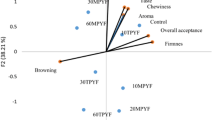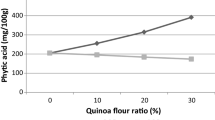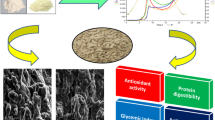Abstract
This study investigated the effect of Maccheronccini fortification with different levels (10, 30 and 50 %) of broad bean flour (Vicia faba) on its nutritional and technological quality. Incorporation of the legume flour significantly increased protein, dietary fibre and mineral contents of produced pasta (P < 0.05). The mineral and protein dietary reference intake (DRI) contributions were higher in enriched pasta considering an intake of 200 g day−1 person−1 (cooked pasta). Cooking losses were relatively low regardless of the substitution level. Colour parameters of produced pasta indicated comparable brightness and higher redness values for enriched pasta. Higher levels of phytates were also found which could compromise iron bioavailability as was predicted through phytate/mineral molar ratios which remained higher than the inhibitory threshold values for calcium and iron intestinal absorption. Enriched pasta showed significantly lower glycaemic index and slightly greater per cent protein digestibility as regard to the control. Produced Maccheronccini pasta had good technological properties with regard to colour and cooking behaviour. Moreover, contribution to DRIs and nutritional value were enhanced upon broad bean flour addition.



Similar content being viewed by others
References
Chillo S, Laverse J, Falcone PM, Del Nobile MA (2008) Quality of spaghetti in base amaranthus wholemeal flour added with quinoa, broad bean and chick pea. J Food Eng 84:101–107
Krishnan JG, Menon R, Padmaja G, Sajeen MS, Moorthy SN (2012) Evaluation of nutritional and physico-mechanical characteristics of dietary fiber-enriched sweet potato pasta. Eur Food Res Technol 234:467–476
Azasa MS, Wassim K, Mensi F, Abdelmouleh A, Brini B, Kraïem MM (2009) Evaluation of faba beans (Vicia fabal L. var. minuta) as a replacement for soybean meal in practical diets of juvenile Nile tilapia Oreochromis niloticus. Aquaculture 287:174–179
Gimenez MA, Gonzalez RJ, Wagnerc J, Torres R, Lobo MO, Samman NC (2013) Effect of extrusion conditions on physicochemical and sensorial properties of corn broad beans (Vicia faba) spaghetti type pasta. Food Chem 136:538–545
Sierra I, Vidal-Valverde C, Kozlowska H (1997) Effect of ripening stage on thiamin and riboflavin levels in lupin, pea and faba bean seeds. Eur Food Res Technol 206:126–129
Abdel-Aal ESM, Hucl P (2002) Amino acid composition and in vitro protein digestibility of selected ancient wheats and their end products. J Food Compos Anal 15:737–747
Bazzano LA, He J, Ogden LG, Loria C, Vupputuri S, Myers L, Whelton PK (2001) Legume consumption and risk of coronary heart disease in US men and women: NHANES I Epidemiologic Follow-up Study. Arch Intern Med 161:2573–2578
Rizkalla SW, Bellisle F, Slama G (2002) Health benefits of low glycaemic index foods, such as pulses, in diabetic patients and healthy individuals. Br J Nutr 88:255–262
Bustos MC, Perez GT, Leon AE (2011) Sensory and nutritional attributes of fibre-enriched pasta. LWT Food Sci Technol 44:1429–1434
Wood JA (2009) Texture, processing and organoleptic properties of chickpea fortified spaghetti with insights to the underlying of mechanism of traditional durum pasta quality. J Cereal Sci 49:128–133
Petitot M, Boyer L, Minier CH, Micard V (2010) Fortification of pasta with split pea and faba bean flours: pasta processing and quality evaluation. Food Res Int 43:634–641
Rayas-Duarte P, Mock CM, Satterleei LD (1996) Quality of spaghetti containing buckwheat, amaranth, and lupin flours. Cereal Chem 73:381–387
Torres A, Frias J, Granito M, Vidal-Valverde C (2007) Germinated Cajanus cajan seeds as ingredients in pasta products: chemical, biological and sensory evaluation. Food Chem 101:202–211
Kaysi Y, Melcion JP (1992) Traitements technologiques des protéagineux pour le monogastrique: exemples d’application à la graine de féverole. INRA 5:3–17
Lopez HW, Krespine V, Guy C, Messager A, Demigne C, Remesy C (2001) Prolonged fermentation of whole wheat sourdough reduces phytate level and increases soluble magnesium. J Agric Food Chem 49:2657–2662
Demi B, Bilgic N, Elgun A, Demi MK (2010) Effects of chickpea flours and whole egg on selected properties of erişte, Turkish noodles. Food Sci Technol Res 16:557–564
Association of Official Analytical Chemists (1996) Methods 925.09: solids (total) and moisture in flour, Method 945.16: oil in cereal adjuncts, Method 991.43: total, soluble, and insoluble dietary fiber in foods. Method 996.11: starch (total) in cereal products, Amyloglucosidase/-Amylase, in official methods of analysis, 15th edn. AOAC, Arlington
Association of Analytical Cereal Chemists (1995) Method 08-03: total ash, Method 46-13: crude protein—Micro-Kjeldahl Method, in approved methods of American Association of Cereal Chemistry, Saint Paul, Minnesota
McCleary BV, McNally M, Rossiter P (2002) Measurement of resistant starch by enzymic digestion in starch and selected plant materials: collaborative study. J AOAC Int 85:1103–1111
Sanz-Penella JM, Laparra JM, Haros M (2014) Impact of α-amylase during breadmaking on in vitro kinetics of starch hydrolysis and glycaemic index of enriched bread with bran. Foods Hum Nutr 69(3):216–221
Gelencser T, Gal V, Hodsagi M, Salgo A (2008) Evaluation of quality and digestibility characteristics of resistant starch-enriched pasta. Food Bioprocess Technol 1:171–179
Duranti M (2006) Grain legume proteins and neutraceutical properties. Fitoterapia 77:67–82
Torres A, Frias J, Granito M, Vidal-Valverde C (2006) Germinated Cajanus cajan seeds as ingredients in pasta products: chemical, biological and sensory evaluation. Food Chem 101:202–211
Sissons MJ, Ames NP, Hare RA, Clarke JM (2005) Relationship between glutenin subunit composition and gluten strength measurements in durum wheat. J Sci Food Agric 85:2445–2452
Sanz-Penella JM, Wronkowsa M, Soral-Smietana M, Haros M (2013) Effect of whole amaranth flour on bread properties and nutritive value. LWT Food Sci Technol 50:679–685
National Academy of Sciences (2005) Chapter 10. Protein and amino acids, in Institute of Medicine Food and Nutrition Board, Dietary references intakes for energy, carbohydrate, fiber, fat, fatty acids, cholesterol, protein and amino acids. NAS, The National Academies Press Washington, pp 589–768
National Academy of Sciences (2015) Institute of Medicine Food and Nutrition Board, in Dietary Reference Intakes: recommended intakes for individuals, vitamins, minerals and macronutrients, NAS. http://iom.edu/Activities/Nutrition/SummaryDRIs/~/media/Files/Activity%20Files/Nutrition/DRIs/New%20Material/5DRI%20Values%20SummaryTables%2014.pdf. Accessed 10 Mar 15
Ma G, Jin Y, Plao J, Kok F, Guusie B, Jacobsen E (2005) Phytate, calcium, iron and zinc contents and their molar ratios in foods commonly consumed in China. J Agric Food Chem 53:10285–10290
Sandhu KS, Lim ST (2008) Digestibility of legume starches as influenced by their physical and structural properties. Carbohydr Polym 71:245–252
Dexter JE, Dronzek BL, Matsuo RR (1978) Scanning electron microscopy of cooked spaghetti. Cereal Chem 5:23–30
Sozer N, Dalgiç AC, Kaya A (2007) Thermal, textural and cooking properties of spaghetti enriched with resistant starch. J Food Eng 81:476–484
Mahe S, Gausseres N, Tome D (1994) Legume proteins for human requirements. Grain Legum 7:15–17
Piwinska M, Wyrwisz J, Kurek M, Wierzbicka A (2015) Hydration and physical properties of vacuum-dried durum wheat semolina pasta with high-fiber oat powder. LWT Food Sci Technol 63:647–653
D’Amico S, Maschle J, Jekle M, Tomoskozi S, Langó B, Schoenlechner R (2015) Effect of high temperature drying on gluten-free pasta properties. LWT Food Sci Technol 63:391–399
Wojtowicz A, Mosciki L (2014) Influence of legume type and addition level on quality characteristics, texture and microstructure of enriched precooked pasta. LWT Food Sci Technol 59:1175–1185
Debbouz A, Pitz WJ, Moore WR, Dappo-lonia BL (1993) Effect of bleaching on durum wheat and spaghetti quality. Cereal Chem 72:128–131
Zhao YH, Manthey FA, Chang SKC, Hou H, Yuan SH (2005) Quality characteristics of spaghetti as affected by green and yellow pea, lentil, and chickpea flours. J Food Sci 70:371–376
Acknowledgments
This work was financially supported by the Project PROMETEO/2012/064 from the Generalitat Valenciana, Spain. The internship grant of Karima Tazrart from the Université Abderrahmane Mira Bejaia, Algeria, is gratefully acknowledged. The authors would like to thank Paolo Diflumeri and Paola D’Agnello from Belladauna Company for their help in the optimization and production of pasta. We would like to thank Dr. Dinoraz Velez and Dr. Vicenta Devesa from the Trace Elements Group (IATA-CSIC) for their help with the sample digestion for mineral determination.
Author information
Authors and Affiliations
Corresponding author
Ethics declarations
Conflict of interest
None.
Compliance with Ethics Requirements
This article does not contain any studies with human or animal subjects.
Rights and permissions
About this article
Cite this article
Tazrart, K., Zaidi, F., Lamacchia, C. et al. Effect of durum wheat semolina substitution with broad bean flour (Vicia faba) on the Maccheronccini pasta quality. Eur Food Res Technol 242, 477–485 (2016). https://doi.org/10.1007/s00217-015-2558-z
Received:
Revised:
Accepted:
Published:
Issue Date:
DOI: https://doi.org/10.1007/s00217-015-2558-z




